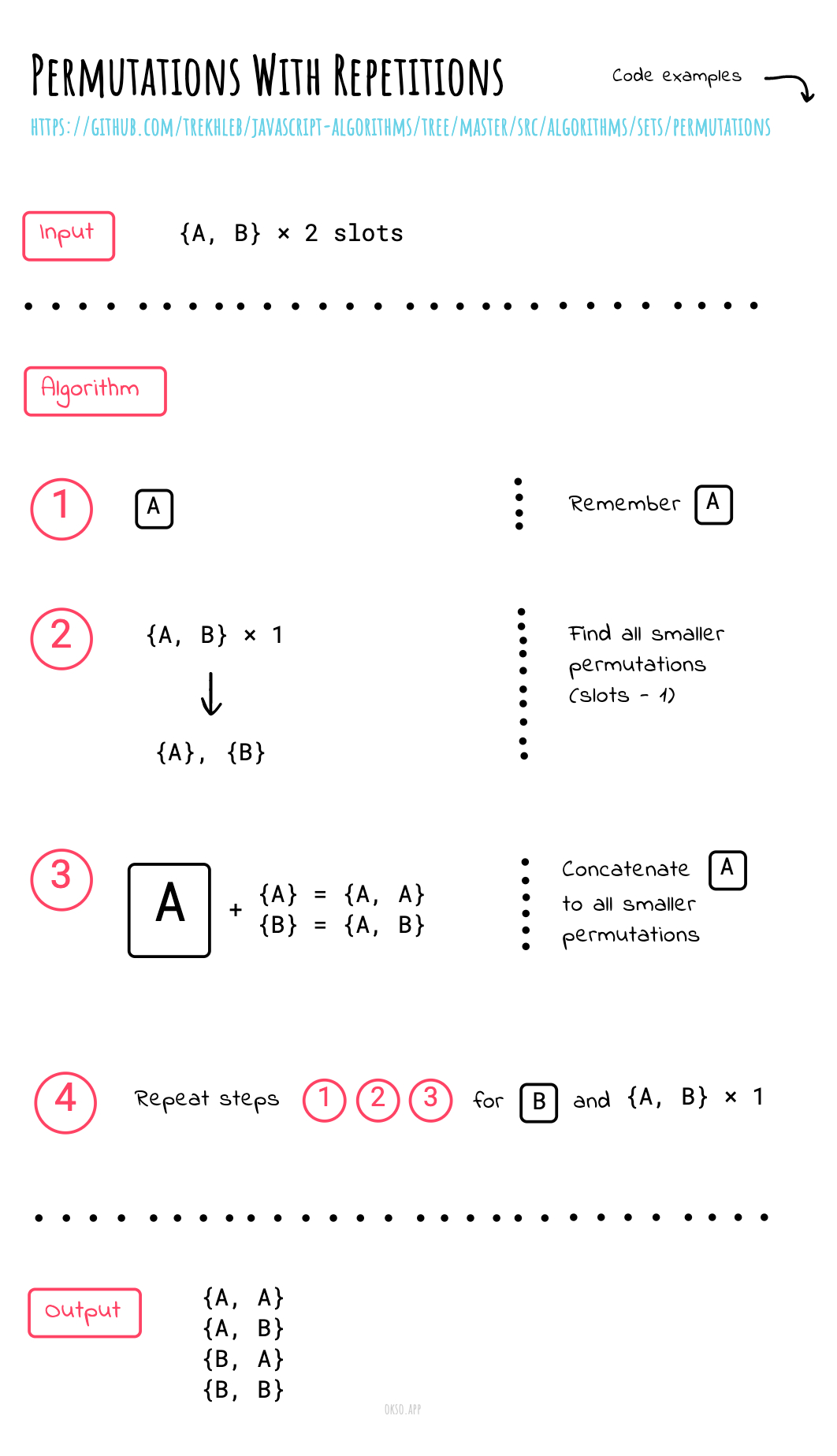# 《程序员数学:排列》- 有/无重复
作者:小傅哥
博客:https://bugstack.cn (opens new window)
源码:https://github.com/fuzhengwei/java-algorithms (opens new window)
沉淀、分享、成长,让自己和他人都能有所收获!😄
# 一、前言
这是一个高中阶段非常常见的数学问题,排序。有 ABC 三个字母,可重复使用字母和不可重复使用字母,都有多少种组合方式。对于这样的问题可以使用公式 A! C! 来计算,不知道你是否已经忘记。
不重复,组合数:n * (n-1) * (n -2) * ... * 1 = n!
可重复,组合数:n * n * n ... (r times) = n^r
这样的计算到不难,但作为程序员我们常常需要把这样的数学问题,用代码逻辑给体现出来。并且还需要考虑一个时间复杂度的问题。
# 二、实现
# 1. 无重复
public static List<List<Integer>> permutationWithRepetitions(int[] permutationOptions, int permutationLength) {
if (permutationLength == 1) {
List<List<Integer>> result = new ArrayList<>();
for (int permutationOption : permutationOptions) {
List<Integer> item = new ArrayList<>();
item.add(permutationOption);
result.add(item);
}
return result;
}
List<List<Integer>> permutations = new ArrayList<>();
List<List<Integer>> smallerPermutations = permutationWithRepetitions(permutationOptions, permutationLength - 1);
for (int currentOption : permutationOptions) {
for (List<Integer> smallerPermutation : smallerPermutations) {
List<Integer> permutation = new ArrayList<>();
permutation.add(currentOption);
permutation.addAll(smallerPermutation);
permutations.add(permutation);
}
}
return permutations;
}
1
2
3
4
5
6
7
8
9
10
11
12
13
14
15
16
17
18
19
20
21
22
2
3
4
5
6
7
8
9
10
11
12
13
14
15
16
17
18
19
20
21
22

这段代码是一个 Java 函数,它生成带重复元素的排列组合。它接受两个参数:
- permutationOptions:排列元素的数组。
- permutationLength:排列的长度,默认为 permutationOptions 的长度。
算法使用递归的方式,如果排列的长度为 1,则将 permutationOptions 数组的每个元素作为一个列表返回;
否则,首先获取不包括第一个元素的小排列,然后将第一个元素插入到每个小排列的每个可能位置上,生成所有排列组合。最后,返回排列组合的列表。
# 2. 可重复
public static List<List<Integer>> permutationWithoutRepetitions(int[] permutationOptions) {
if (permutationOptions.length == 1) {
List<List<Integer>> result = new ArrayList<>();
result.add(List.of(permutationOptions[0]));
return result;
}
List<List<Integer>> permutations = new ArrayList<>();
int[] smallerOptions = new int[permutationOptions.length - 1];
System.arraycopy(permutationOptions, 1, smallerOptions, 0, smallerOptions.length);
List<List<Integer>> smallerPermutations = permutationWithoutRepetitions(smallerOptions);
int firstOption = permutationOptions[0];
for (List<Integer> smallerPermutation : smallerPermutations) {
for (int positionIndex = 0; positionIndex <= smallerPermutation.size(); positionIndex++) {
List<Integer> permutationPrefix = new ArrayList<>(smallerPermutation.subList(0, positionIndex));
List<Integer> permutationSuffix = new ArrayList<>(smallerPermutation.subList(positionIndex, smallerPermutation.size()));
List<Integer> permutation = new ArrayList<>(permutationPrefix);
permutation.add(firstOption);
permutation.addAll(permutationSuffix);
permutations.add(permutation);
}
}
return permutations;
}
1
2
3
4
5
6
7
8
9
10
11
12
13
14
15
16
17
18
19
20
21
22
23
2
3
4
5
6
7
8
9
10
11
12
13
14
15
16
17
18
19
20
21
22
23

- 这段 Java 代码实现了一个递归算法,它生成不带重复项的整数序列的全排列。它首先特判了如果传入的数组只有一个元素,那么返回一个只包含这个元素的 List。
- 否则它将传入的数组分为两部分:第一个元素和剩下的元素。它先递归计算剩下的元素的全排列,然后将第一个元素插入到每个全排列的每一个可能位置。最后将所有的排列组合起来,返回结果。
# 三、测试
@Test
public void test_permutationWithRepetitions() {
int[] permutationOptions = {1, 2, 3};
List<List<Integer>> permutation = Permutations.permutationWithRepetitions(permutationOptions, 2);
for (List<Integer> list : permutation) {
System.out.println(JSON.toJSONString(list));
}
}
@Test
public void test_permutationWithoutRepetitions() {
int[] permutationOptions = {1, 2, 3};
List<List<Integer>> permutation = Permutations.permutationWithoutRepetitions(permutationOptions);
for (List<Integer> list : permutation) {
System.out.println(JSON.toJSONString(list));
}
}
1
2
3
4
5
6
7
8
9
10
11
12
13
14
15
16
17
2
3
4
5
6
7
8
9
10
11
12
13
14
15
16
17
测试结果
[1,1]
[1,2]
[1,3]
[2,1]
[2,2]
[2,3]
[3,1]
[3,2]
[3,3]
Process finished with exit code 0
1
2
3
4
5
6
7
8
9
10
11
2
3
4
5
6
7
8
9
10
11
https://www.mathsisfun.com/combinatorics/combinations-permutations.html (opens new window)

